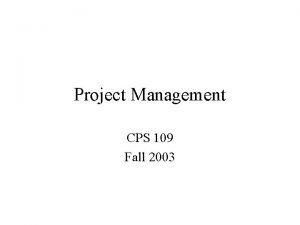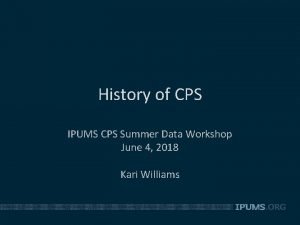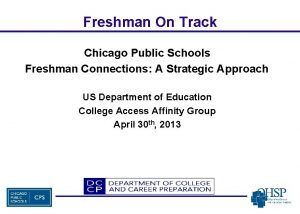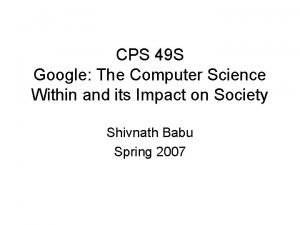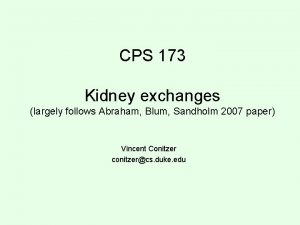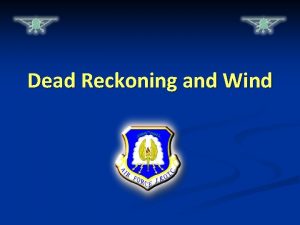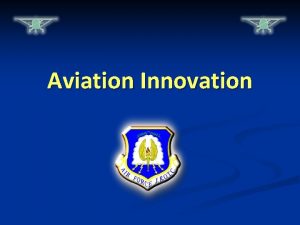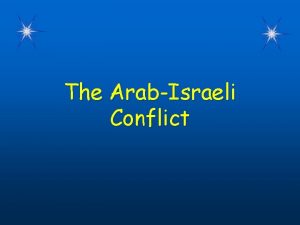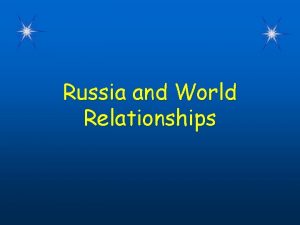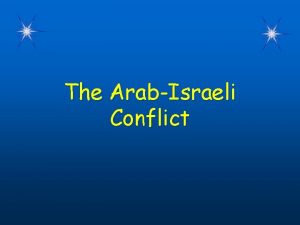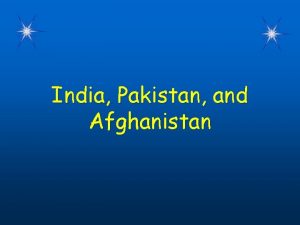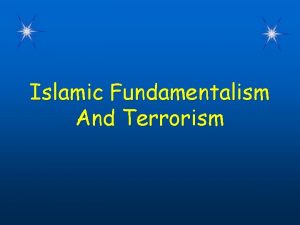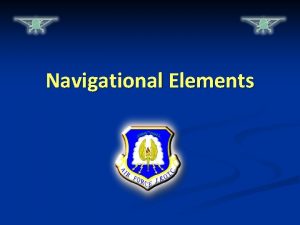Africa An Introduction WarmUp Questions CPS Questions 1


























- Slides: 26

Africa: An Introduction

Warm-Up Questions CPS Questions (1 - 2) Chapter 3, Lesson 1

Chapter Overview Ø Lesson 1: Africa: An Introduction Ø Lesson 2: The Shadow of Western Colonialism Ø Lesson 3: Dictatorship, Leadership Challenges, and Ethnic Clashes Ø Lesson 4: AIDS, Health, Poverty, and Human Rights Ø Lesson 5: US Interests and Regional Issues in Africa Chapter 3, Lesson 1

Lesson Overview Ø The five major regions of Africa Ø The natural resources of Africa Ø The distinctive characteristics of Africa Ø The main ethno-linguistic groups in Africa Ø The main language groups in Africa Ø How Islam, Christianity, and indigenous religions influence Africa Chapter 3, Lesson 1

Quick Write How do you think this knowledge about the origins of modern humans affects the way most people think about Africa? How does it make you think about Africa? (Note to teacher: Use “Pick a Student” button in CPS) Chapter 3, Lesson 1

The Five Major Regions of Africa Ø North Africa Ø West Africa Ø Central Africa Ø Eastern Africa Ø Southern Africa Chapter 3, Lesson 1 Mary Knox Merrill / © 2009 The Christian Science Monitor

The Natural Resources of Africa Ø Mineral Resources ØDiamonds ØGold ØOther minerals: Chromite, Cobalt, Manganese, & Uranium Ø Nigeria, Angola, and Sudan also have significant oil resources Chapter 3, Lesson 1 Neal J. Menschel / © 1990 The Christian Science Monitor

The Natural Resources of Africa, cont. Ø Agricultural Resources Ø“Agriculture will provide the engine for growth in Africa” ØMost African farmers are subsistence farmers Chapter 3, Lesson 1 Melanie Stetson Freeman / © 2008 The Christian Science Monitor

Conflicts Over Resources Ø Controversy rages over who “owns” natural resources Ø In civil war, one faction gains illegal control over a resource and uses the money it earns to supply its troops so it can keep fighting Chapter 3, Lesson 1

The Distinctive Characteristics of African Culture Ø A strong system of extended families is an essential part of traditional African cultures Ø Polygamy’s Impact ØAlthough polygamy is widespread in Africa, it’s been controversial for a long time Ø The Significance of Oral Tradition ØAfrica is a continent of storytellers Chapter 3, Lesson 1

The Main Ethno-Linguistic Groups in Africa Ø An ethno-linguistic group is a group of people who share a common language and culture Ø Black Africans are the original inhabitants of sub-Saharan Africa Chapter 3, Lesson 1 Melanie Stetson Freeman / © 2006 The Christian Science Monitor

The Main Ethno-Linguistic Groups in Africa, cont. Ø The Arabs and Berbers live mostly in North Africa ØPredominantly Muslim Ø Afrikaners and Other Europeans ØIn the 17 th and 18 th centuries, Dutch, German, and French Protestant farmers settled in what is now South Africa Chapter 3, Lesson 1 R. Norman Matheny / © 1992 The Christian Science Monitor

The Main Ethno-Linguistic Groups in Africa, cont. Ø People of Mixed Race and Asians ØIn South Africa, coloured is the proper way to refer to people of mixed race ØIn Africa, Asians refers to people from the India subcontinent Chapter 3, Lesson 1 Melanie Stetson Freeman / © 2002 The Christian Science Monitor

The Main Language Groups in Africa Ø Africa has more languages spoken than any other continent—about 2, 000 Ø Most have very small numbers of speakers Ø The languages of Africa are classified in four major families: ØNiger-Congo ØAfro-Asiatic ØNilo-Saharan ØKhoisan Chapter 3, Lesson 1

The Roles of European and Asian Languages Ø Many Africans speak more than one language Ø In countries with many different indigenous—native—languages, no one tongue is dominant Chapter 3, Lesson 1

How Islam, Christianity, and Indigenous Religions Influence Africa Ø Africa is a lively spiritual marketplace Ø Despite the rise of Christianity and Islam in Africa, traditional religions are still important Chapter 3, Lesson 1 Mary Knox Merrill / © 2009 The Christian Science Monitor

How Islam, Christianity, and Indigenous Religions Influence Africa, cont. Ø Unfortunately, the large numbers of Christians and Muslims living near each other in many African countries sometimes leads to conflicts Chapter 3, Lesson 1 Melanie Stetson Freeman / © 1995 The Christian Science Monitor

Learning Check CPS Questions (3 - 4) Chapter 3, Lesson 1

Activity 1: Geographic Locations in Africa Identify the correct country and draw in the locations of the Sahara Desert, the Nile River, and Mount Kilimanjaro. Chapter 3, Lesson 1

Activity 2: Africa’s Natural Resources Academic Challenge “Family Feud” style activity Each correct answer is worth 100 points Good Luck!! Chapter 3, Lesson 1

Activity 3: Comparing African and American Geography and Culture Use the Venn diagram to compare/contrast African geography and culture to American geography and culture. Chapter 3, Lesson 1

Technology Enrichment: Researching the Cultural Contributions of Africa Research the literary, architectural, artistic, and cultural contributions your region of Africa has made to the world. Chapter 3, Lesson 1

Review Ø The five major regions of Africa are: North, West, Central, Eastern, and Southern Ø The natural resources of Africa include mineral, oil, and agricultural Ø A strong system of extended families is an essential part of traditional African cultures Ø Africa has more languages spoken than any other continent—about 2, 000 Ø Africa is a lively spiritual marketplace Chapter 3, Lesson 1

Review Questions CPS Questions (5 - 6) Chapter 3, Lesson 1

Summary Ø The five major regions of Africa Ø The natural resources of Africa Ø The distinctive characteristics of African culture Ø The main ethno-linguistic groups in Africa Ø The main language groups in Africa Ø How Islam, Christianity, and indigenous religions influence Africa Chapter 3, Lesson 1

Next…. Ø Done—Africa: An Introduction Ø Next—The Shadow of Western Colonialism Chapter 3, Lesson 1 Scott Baldauf / © 2009 The Christian Science Monitor
 Warmup ratio
Warmup ratio Warmup 65
Warmup 65 Gmass warmup
Gmass warmup Status vs class
Status vs class Pyramid warmup
Pyramid warmup Warm rhyming words
Warm rhyming words Properties warmup
Properties warmup Java warmup
Java warmup Define:warmup
Define:warmup Persuasive essay quotes
Persuasive essay quotes Tinman schwartz
Tinman schwartz Warmup 65
Warmup 65 Warmup end
Warmup end Cps algebra exit exam
Cps algebra exit exam Cps in project management
Cps in project management Ipums cps
Ipums cps Cps freshman connection
Cps freshman connection Cps special investigator
Cps special investigator Cps molve
Cps molve Continuation passing style
Continuation passing style Cps 506 ryerson
Cps 506 ryerson Cps 506
Cps 506 Cps 49
Cps 49 Cps 173
Cps 173 Cps 1s
Cps 1s Cps 173
Cps 173 L-3 combat propulsion systems
L-3 combat propulsion systems














